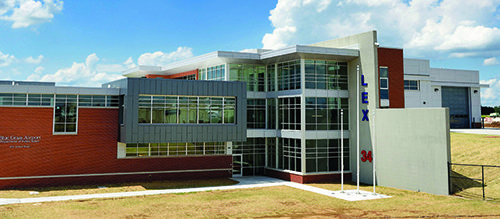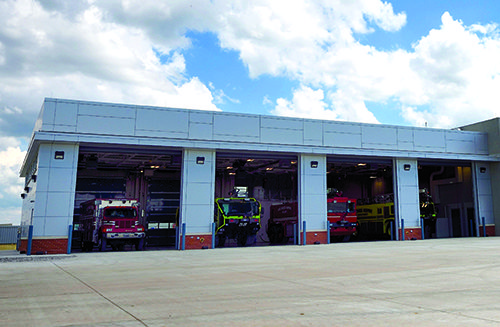Lexington Blue Grass Airport (LEX) is on pace to open a new three-story aircraft rescue and firefighting (ARFF) facility in August. Completion of the $15 million ARFF station moves the Kentucky airport one important step closer to finishing its five-phase program to enhance taxiway safety.
Lexington Blue Grass Airport (LEX) is on pace to open a new three-story aircraft rescue and firefighting (ARFF) facility in August. Completion of the $15 million ARFF station moves the Kentucky airport one important step closer to finishing its five-phase program to enhance taxiway safety. The final phase—reconfiguring and reconstructing a 1,000-foot connector taxiway—is scheduled to conclude this November.
 Mark Day, development and facilities director at LEX, notes that the five-phase, $66 million initiative required careful phasing over the last eight years. “The endgame was reconfiguration of our parallel Taxiway A and primary connector Taxiway C,” Day explains. “Being a small airport, we don’t have a number of taxiways, and we were experiencing some head-to-head traffic issues during congested times of the day. Additionally, one of the taxiways was positioned in a blind spot for air traffic controllers. One of our airlines must call for gate pushback because its aircraft have to back onto an active taxiway.”
Mark Day, development and facilities director at LEX, notes that the five-phase, $66 million initiative required careful phasing over the last eight years. “The endgame was reconfiguration of our parallel Taxiway A and primary connector Taxiway C,” Day explains. “Being a small airport, we don’t have a number of taxiways, and we were experiencing some head-to-head traffic issues during congested times of the day. Additionally, one of the taxiways was positioned in a blind spot for air traffic controllers. One of our airlines must call for gate pushback because its aircraft have to back onto an active taxiway.”
|
Project: New Aircraft Rescue & Firefighting Facility Location: Lexington (KY) Blue Grass Airport Size: 3 stories; 23,196 sq. ft. Cost: $15 million Funding: Airport Improvement Program grant (72%); airport funding (28%) Construction: Aug. 2018 – Aug. 2020 Master Plan & Prime Project Consultant: Crawford, Murphy & Tilly Inc. Architect: CR-architecture + design Construction Administrator: HDR Inc. Program Manager: Connico Inc. General Contractor: The Walker Co. Interior Design & Furniture: KPC Architectural Products Inc. with CR-architecture + design Access Control: Matrix Systems Crash Phone System: Forum Communications Of Note: New ARFF station is part of airport’s $66 million taxiway safety enhancement program, completed in 5 phases |
To resolve the taxiway issue, the airport had to tear down its existing ARFF facility, which was built in 1979. An FAA site-selection study determined the preferred location for a new firehouse was several hundred feet to the southwest, where the maintenance facility was located. The airport consequently removed that building in 2015, reconstructed a new maintenance center on the south side of the airfield, and filled in the valley where the new ARFF station would be built.
“All these dominoes had to fall in the right order to achieve our ultimate goal of reconfiguring our taxiways,” Day summarizes.
Fortunately, the genesis of LEX’s five-phase plan helped secure federal funding for the new ARFF facility. In 2013, LEX and its master plan consultant, Crawford, Murphy and Tilly, identified airfield geometry and operational complexity in the core taxiway and aircraft movement areas near the passenger terminal as priority concerns. During this same period, the FAA was focusing heightened attention on these issues.
The airport subsequently hired Crawford, Murphy and Tilly as prime consultant for the taxiway safety enhancement program, including construction of the new ARFF facility.
Brad Hamilton, the firm’s senior vice president and director of Aviation Services, notes that planning and coordination with FAA allowed the airport to address its airfield priorities within a single program. “This freed significant federal dollars for a new ARFF station because it could be included as part of an enabling project for a larger taxiway safety enhancement program,” Hamilton explains.
 The overarching goal for the ARFF facility project was to provide optimal access to the airfield and terminal while leveraging existing infrastructure to minimize costs. When choosing a location, planners prioritized response times to the airfield and passenger terminal, and considered overall site development challenges. Ultimately, the location selected required deep foundation and soil stabilization, ground water and stream resource protection, consolidation of nested utilities, a secondary collection area for terminal ramp deicing effluents and a multilevel fire station design to address significant differences between landside and airside pavement elevations.
The overarching goal for the ARFF facility project was to provide optimal access to the airfield and terminal while leveraging existing infrastructure to minimize costs. When choosing a location, planners prioritized response times to the airfield and passenger terminal, and considered overall site development challenges. Ultimately, the location selected required deep foundation and soil stabilization, ground water and stream resource protection, consolidation of nested utilities, a secondary collection area for terminal ramp deicing effluents and a multilevel fire station design to address significant differences between landside and airside pavement elevations.
Site Prep
The Walker Company, general contractor for the project, had to perform extensive excavation and fill work to ready the site for the new ARFF station. Jim Chandler, the firm’s project manager at LEX, notes that portions of the new building sit on 55 feet of engineered materials. All of the engineered fill was quarried on airport property, and materials excavated from the site were used for taxiway extension work during phase five, adds Chandler.
The location that was selected according to FAA advisory circular guidelines was basically a valley that needed to be filled, explains Day. Rather than waiting years for the fill to settle, engineers used H piles driven into solid bedrock to anchor the building and prevent associated foundation cracking.
 Construction of the new ARFF station began in August 2018. “Specifications for the project were quite stringent,” recalls Chandler. “Driving piles and placing concrete for grade beams and walls required precise planning and coordination. For example, piles could not be driven within 200 feet of freshly poured concrete for a minimum of seven days. Given the building’s footprint, this was next to impossible.”
Construction of the new ARFF station began in August 2018. “Specifications for the project were quite stringent,” recalls Chandler. “Driving piles and placing concrete for grade beams and walls required precise planning and coordination. For example, piles could not be driven within 200 feet of freshly poured concrete for a minimum of seven days. Given the building’s footprint, this was next to impossible.”
To work around this conflict and stay on schedule, crews drove piles on days when other contractors would not be working due to inclement weather. “We adjusted the number of piles driven per day, and opened up more footings than usual in order to drive piles and still adhere to specifications,” says Chandler. “Structural reinforcements were installed and concrete was poured in massive amounts. Concrete pump trucks were set up to pour concrete on one side of the building, then moved as needed.”
One portion of the taxiway had to be shut down for four consecutive months, which required aircraft to back-taxi on the runway. To avoid associated conflicts, work was often scheduled between midnight and 5 a.m. “We were trying to compress an eight-hour day into a five-hour shift,” Chandler recalls.
Although aircraft traffic slowed during winter months, operations continued throughout construction. Contractors used admixtures to prevent the concrete from freezing, and kept the subgrade warmed to a specified temperature. “While pouring concrete and driving piles during winter months were challenging to say the least, we were able to rise to the challenge with the help of our suppliers and subcontractors,” says Chandler.
All told, crews installed 320 H piles, 47,055 square yards of concrete pavement, 37,500 square yards of cement base, 56,280 square yards of crushed aggregate base and 2,200 cubic yards of structural concrete for the ARFF building.
Strength & Comfort
The sloped terrain of the building site influenced how the 23,196-square-foot facility is organized. Public spaces are located on the lower level, primary ARFF functions are housed on the airfield level, and observation/operations space is on the upper level. As a whole, the building itself also serves as part of the airfield’s perimeter security. Fencing extends off the new structure to the north and south.
The lower level contains a large training/conference room, which is also designed to serve as an emergency operations center. Maintenance spaces and a fitness center for on-duty public safety officers are also located there.
 The first floor, located at the airfield level, includes four bays for firefighting apparatus (two back-in and two drive-through), administrative spaces and residential facilities. A tool room, hose drying/training tower, supply room and areas for storing foam and chemical firefighting agents sit behind the back-in bays. This arrangement helps maximize use of space, notes Director of Public Safety and Operations Scott Lanter.
The first floor, located at the airfield level, includes four bays for firefighting apparatus (two back-in and two drive-through), administrative spaces and residential facilities. A tool room, hose drying/training tower, supply room and areas for storing foam and chemical firefighting agents sit behind the back-in bays. This arrangement helps maximize use of space, notes Director of Public Safety and Operations Scott Lanter.
The two-story apparatus bay has a mezzanine with a stairwell and window that will be used for training purposes. Crew members can rappel over the mezzanine railing and move gear up and down the stairwell.
“If public safety officers have to go offsite for training, it costs money for travel, room and board and replacement crews while they are gone,” explains David Sweeney, senior project manager with CR-architecture + design. “Our goal with this project was to design spaces that are flexible and useful—for example, a training room that can be turned into an emergency operations center.”
The living area includes six one-person suites surrounded on all sides by a hallway, offices space and interior walls to help minimize noise in the sleeping areas. The large, open kitchen is stocked with commercial appliances; and expansive windows let in abundant natural light and overlook grassy areas outside. A roomy patio off the kitchen provides safety officers a private area with fresh air and views of rolling hills in the distance.
The upper level offers prime views of the runway and taxiway areas. In addition to its current role as a radio communications and airfield observation room, the space was designed with the goal of moving airport operations there within the next couple of years, informs Lanter.
One of the primary design elements of the structure is a massive 42-foot concrete spline wall that runs through the center of the building. “It is designed to anchor the building and offer a highly visible interior and exterior presence,” explains Sweeney. “It helps organize the building’s interior functions, with the apparatus bay on the east side of the wall and the residential/communal functions on the west side. The 18-inch-thick wall rises above the roof of the building; it grounds and anchors the building while serving as a visual icon.”

 Sweeney notes that architects and designers had to walk a fine line to make the new ARFF station feel solid and architecturally secure, but also approachable and welcoming. “We don’t want the building to feel like a fortress. We want it to feel like a place where you want to go to work,” he explains. “The building not only provides shelter for equipment, it is designed to enhance the health and well-being of the crews that work and live there for extended periods.”
Sweeney notes that architects and designers had to walk a fine line to make the new ARFF station feel solid and architecturally secure, but also approachable and welcoming. “We don’t want the building to feel like a fortress. We want it to feel like a place where you want to go to work,” he explains. “The building not only provides shelter for equipment, it is designed to enhance the health and well-being of the crews that work and live there for extended periods.”
To that end, designers incorporated an abundant amount of windows to draw as much light as possible deep into the interior spaces. Ivory and cream wall colors with warm reddish doors soften the interior spaces to help counteract mental/physical stress and promote health and wellness, he adds.
Lanter is not surprised that crews and airport officials alike are pleased with the final product. During the initial concept stage of the project, project planners asked public safety officers to make a wish list of what they wanted in the new station; and the team used that list as a starting point in the design process. “We are proud of the fact that we have a station that is basically designed by our public safety officers,” he reflects. “I’d say it meets 95% of what they requested.”


 facts&figures
facts&figures

